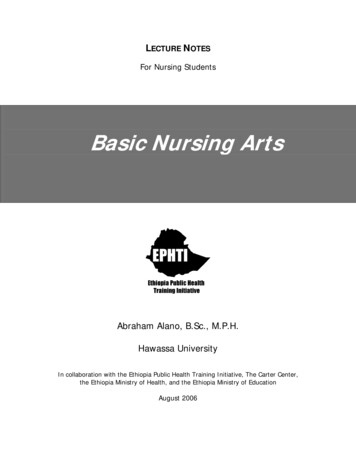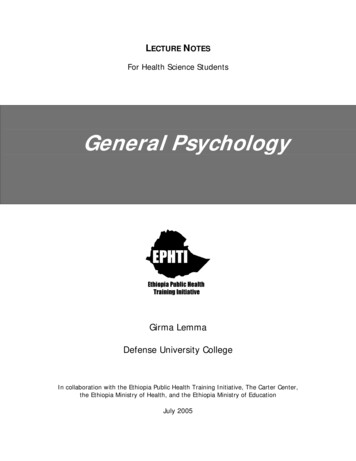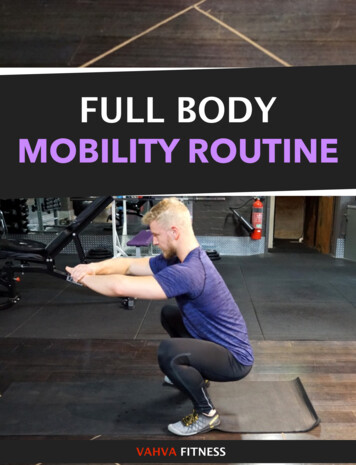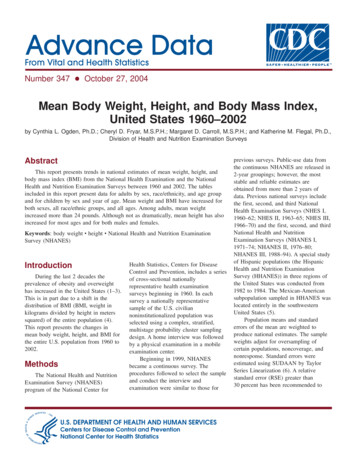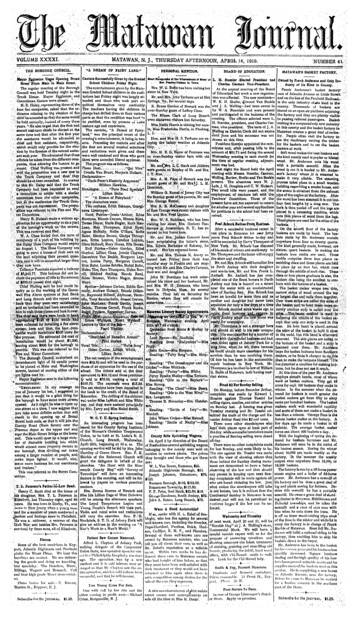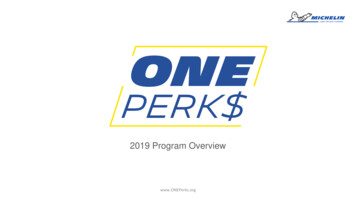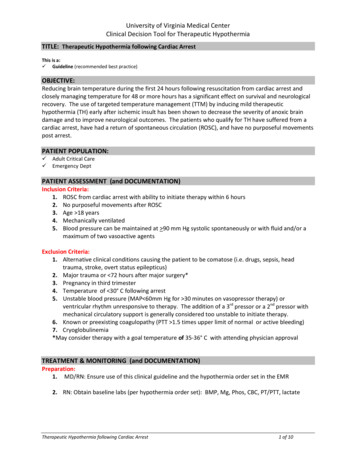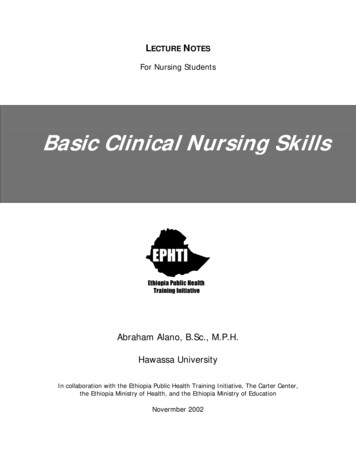
Transcription
LECTURE NOTESFor Nursing StudentsBasic Clinical Nursing SkillsAbraham Alano, B.Sc., M.P.H.Hawassa UniversityIn collaboration with the Ethiopia Public Health Training Initiative, The Carter Center,the Ethiopia Ministry of Health, and the Ethiopia Ministry of EducationNovermber 2002
Funded under USAID Cooperative Agreement No. 663-A-00-00-0358-00.Produced in collaboration with the Ethiopia Public Health Training Initiative, The CarterCenter, the Ethiopia Ministry of Health, and the Ethiopia Ministry of Education.Important Guidelines for Printing and PhotocopyingLimited permission is granted free of charge to print or photocopy all pages of thispublication for educational, not-for-profit use by health care workers, students orfaculty. All copies must retain all author credits and copyright notices included in theoriginal document. Under no circumstances is it permissible to sell or distribute on acommercial basis, or to claim authorship of, copies of material reproduced from thispublication. 2002 by Abraham Alano,All rights reserved. Except as expressly provided above, no part of this publication maybe reproduced or transmitted in any form or by any means, electronic or mechanical,including photocopying, recording, or by any information storage and retrieval system,without written permission of the author or authors.This material is intended for educational use only by practicing health care workers orstudents and faculty in a health care field
PREFACENursing is core part in health service delivery system in which healthpromotion, disease prevention; curative and rehabilitative healthstrategies are applied. The clinical nursing skills for the nurses areof paramount important not only to provide comprehensive care butalso enhance clinical competence. The purpose of preparing thislecture note is to equip nurses with basic clinical nursing skills, whichwill enable them to dispatch their responsibility as well as to developuniformity among Ethiopian Professional Nurse Training HigherInstitutions.The lecture note series is designed to have two parts: part-I iscomposed of most basic clinical skills, where as part two will becovering most advances clinical skills as well as fundamentalconcepts related to the skills. It is well known that no nursing servicecan be provided with out basic clinical nursing skills. For nurse toprovide health service at different settings; hospital, health center,health post and at the community level including home based carefor chronically sick patients, the course is very essential. It is alsohoped that other primary and middle level health professionaltraining institution will utilize the lecture notes to rational exercise theprofessional skills.The lecture note is therefore organized in logical manner thatstudents can learn from simpler to the complex. It is divided in tounits and chapters. Important abbreviations and key terminologiesi
have been included in order to facilitate teaching learning processes.On top of that learning objectives are clearly stated to indicate therequired outcomes. Glossary is prepared at the end to giveexplanation for terminologies indicated as learning stimulants atbeginning of each chapter following the learning objectives. Trial ismade to give some scientific explanation for procedure and somerelevant study questions are prepared to each chapter to aidstudents understand of the subject.To enhance systematicapproach in conducting nursing care the nursing process is alsoindicated for most procedures.ii
ACKNOWLEDGEMENTMy deepest appreciation is to The Carter Center, EPHTI andProfessor Dennis Carlson, senior consultant of the Center for histireless efforts to materialize the issue of staff strengthening andcurriculum development. Lecture note preparation is one of theactivities that got due attention to strengthen the teaching learningprocess in Ethiopia by Ethiopian staff. There fore, I congratulateProfessor Denis Carlson for the success you achieved withdedicated Ethiopian partners.I also extend many thanks to colleagues and staff of our School ofNursing particularly Ato Andargachew Kassa and Ato Aweke Yilmafor their valuable comments and criticism, other wise the lecture notewould have not been shaped this way.I would like to extend my thanks to Ato Asrat Demissie AcademicVice President of Defence University College and Ato DanielMengistu Head of School of Nursing in University of Gondar for theircritical review and valuable comments.My sincere gratitude is also to the staff members of schools ofnursing, sister Universities, (Ato Birara Tadeg, GU, Ato GetachewWorku, DUC, Sr. Netsanet Shiferaw, JU, Ato Tesfaye Abebe, HU)for their tireless and meticulous revision of the material otherwisedifficulties would have faced to shape this way.iii
Similarly, my felt thanks is to supportive staff of The Carter CenterEPHTI, Dr Hailu Yenenh, Ato Aklilu Mulugetta , W/rt MeseretTsegaw and all other staff for their devoted support through thepreparation of this lecture note.Next, I thank all our College authorities for permission to work onthis lecture note besides the routine activities of the college.Last but not least, my deepest gratitude is to W/rt Lemlem Adebabaywho has managed to write the document with in very urgency givingup her rest time and comfort.iv
TABLE OF CONTENTSContentPagePreface . iAcknowledgement . iiiTable of Contents. vList of Figures . xiiAbbreviation . xiiiUnit OneChapter 1 . 1Introduction . 1Definition of nursing . 1Historical background of nursing . 2History of nursing in Ethiopia . 8Nursing process and Critical thinking . 10Unit Two Safety in Health Care facilities . 18Chapter 2: infection control/ universal precaution . 18Nursing process application. 19Normal body defense . 22Chain of infection . 24Basic medical asepsis . 26v
Hand washing . 26Standard precaution . 29Surgical asepsis. 33Isolation. 37Chapter 3: Care of patient unit. 49The patient unit . 50Care of hospital and health care unit equipment . 54Unit Three Basic Client Care . 58Chapter 4: Admission, Transfer, and Discharge of client . 58Admission . 59Transfer. 61Discharge. 62Chapter 5: Vital Signs . 66Definition .Temperature . 69Pulse . 77Respiration. 82Blood pressure. 83Chapter 6: Specimen collection . 90General consideration for specimen collection. 91Collecting stool specimen . 92Collecting urine specimen. 94Collecting sputum . 99Collecting blood specimen. 101Chapter 7: Bed making . 109Closed bed . 110vi
Occupied bed. 110Post operative bed. 112Chapter 8: Personal hygiene and skin care. 120Mouth care . 120Bathing. 125Bed bath. 128Therapeutic bath. 131Back care . 134Giving and receiving bedpan and urinals . 138Perineal care. 140Hair cares. 145Pediculosis treatment . 150Chapter 9: Cold & heat application . 158Care of a patient with fever. 158Heat application . 159Cold application . 160Tepid sponge . 160Local application of cold and heat . 161Application of cold . 161Application of heat . 163Sitiz bath . 164Chapter 10: Body mechanics and mobility . 167Body mechanics . 168Basic principles of body mechanics. 168Turning the patient to a side lying position . 172Joint mobility and range of motion. 173vii
Body positioning . 177Guideline for positioning the client. 177Client positioning for examination & treatment. 179Crutch walking . 183Application of nursing process. 183Teaching technique for crutch walking . 184Teaching up stair and down stair walking withcrutch . 189Helping the client into wheel chair . 190Unit Four . 194Chapter 11 Nutrition and metabolism . 194Fluid and electrolyte balance. 194Acid base balance . 200Nutrition. 208Gastrostomy/jejunostomy feeding . 211Inserting a gastric tube . 211Nasogastric feeding . 217Total parentral nutrition. 221Unit FiveChapter 12Elimination of Gastro Intestinal and Urinary Tractoutputs.229Gastric lavage .230Gastric aspiration .234viii
Enema .236Cleansing enema .237Retention enema.241Rectal washout.242Passing flatus tube .243Urinary catheterization .244Catheterization using straight catheter .246Inserting indwelling catheter.249Unit SixChapter 13Medication Administration .252Definition of pharmacology.252Drug metabolism .253Factors affecting drug metabolism.255Drug administration .256Application of nursing process .257Oral drug administration.259Suppository .263Subcutaneous injection .267Intramuscular injection .269Intravenous injection .273ix
Intravenous therapy .275Blood transfusion .278Cut down .283Administration of vaginal medications.285Administration of ophthalmicmedication .287Administration of otic medications .290Inhalation.292Definition of inhalation.292Oxygen administration .292Giving oxygen by mask .292Giving oxygen by nasal catheter.294Giving oxygen by tent.295Steam inhalation .297Nelson’s inhalor.298Unit SevenChapter 14 Wound cares .303Definition .303Wound healing process.304Dressing a clean wound.304Dressing of septic wound .307Dressing with a drainage tube.309x
Wound irrigation .312Suturing .314Removal of stitch.316Clip application and removal .318Unit EightChapter 15 Perioperative nursing cares .321Preoperative care.321Care the day before surgery .325Care at the day of surgery.326Care just before surgery.327Intraoperative care .332Postoperative care .332Unit NineChapter 16 Care of the dying & Post-mortem care . 338Definition .338Stages of dying.340Spirituality of dying .339Assisting the dying .343Care after death .346Glossary .349References .363xi
LIST OF FIGURESFigure 1. Chain of infection . 24Figure 2. Site for radial pulse measurement . 80Figure 3. Horizontal recumbent position . 179Figure 4. Dorsal recumbent position . 179Figure 5. Prone position . 180Figure 6.Sim position. 180Figure 7. Fowler’s position . 181Figure 8. Knee-chest position. 181Figure 9. Lithotomy position . 182Figure 10. Four –point-gait . 185Figure 11. Three-point-gait. 186Figure 12. Two-point-gait . 187Figure 13. Sites for IM injection. 271Figure 14. Suture removal technique . 316xii
ABBREVATIONS & SYMBOLSABGArterial Blood GasAbAntibodyABCDEAirway, breathing, circulation, disability, expose andexamineA.C.Before meal (ante cibum)ACTHAdreno cortico trophic hormoneAD.As desiredADLActivities of daily livingAIDSAcquire immeno deficiency syndromeAIAdequate intakeAM.MorningAMALGAmalgam fillingAMAAgainst medical adviceA and PAuscultation and percussionAPCAspirin, Phenacetine & caffeineAPApical pulse or antero-posteriorAQAqueousA-RApical radial pulseAROMActive range of motion; artificial rapture ofmembraneAxBIDAxillaryTwice a day (bis in die)xiii
B.MBowel movementB.M.R.Basal metabolic rateB.PBlood pressureBPMBeat perminuliB.R.P.Bathroom privilegeBUNBlood urea nitrogenoCCentigradeC.B. CComplete blood countCCCubic centimeterC.N. S.Central nervous systemCo2Carbon dioxideC.S. F.Cerebro- spinal fluidCXRChest X-rayD and CDilatation and CurettageD/NSDextrose in normal salineDPTDiphtheria, pertusis, tetanusD/WDextrose in waterDxDiagnosisEEGElectro encephalogramE.E.N.T.Eye, ear, nose, g blood sugarF.H.B.Fetal heartbeatG.I.Gastro intestinalG or GmGramxiv
gr.Graingt.Drop (gutte)gtt.DropsG.U.Genito urinaryGYN.GynecologyHCLHydrochloric acidHbHemoglobinHSAt bed- time (hours of sleep)H2oWaterI.V.IntravenousI.V.PIntravenous pyelogramKI.Potassium iodideL. PLumbar punctureNaClSodium ChlorideNOCTEAt nightN.P.O.Nothing by mouth (nothing by os)O.P.D.Out Patient DepartmentO.R.Operating roomPMAfter noonPRNAs needed, when necessaryPt.PatientQ.EveryQ.D.Every DayQ.H.Every HourQ.I.D.Four times a dayQ.N.Every nightxv
Q.O.D.Every other dayR.B.C.Red blood count or red blood cellRh.Rhesus factorRxPrescription, takeSol.SolutionSOSIf necessarySTATImmediately -at onceS.CSubcutaneousT. I.DThree times a dayT.P.R.Temperature, pulse, respirationTspTeaspoon, tablespoonU.R.Upper rightWBCWhite blood cellsWt.WeightU.R.Q.Upper right quadrantU.L.Q.Upper lower quadrantUTIUrinary tract Infectionxvi
Basic Clinical Nursing SkillsUNIT ONECHAPTER 1INTRODUCTIONLearning Objectives:After completing this unit, the learners will be able to: State the modern definition of nursing Outline the historical background of nursing world wide andin Ethiopia Identify the contribution of significant individuals in nursing Describe the nursing process Describe critical thinking as an instrument for provision ofquality careNursingDefinition:“It is the diagnosis and treatment of human responses to actual orpotential health problems” (ANA 1980).It is assisting the individual, sick or well in the performance of thoseactivities contributing to health or its recovery (to peaceful death)that he will perform unaided, if he had the necessary strength, will orknowledge and to do this in such a way as to help him gainindependence as rapidly as possible (Virginia Henderson 1960).1
Basic Clinical Nursing SkillsNursing is the art and science that involves working with individual,families, and communities to promote wellness of body, mind, andspirit.It is a dynamic, therapeutic and educational process thatserves to meet the health needs of the society, including its mostvulnerable members.Historical Background of NursingNursing has a history as long as that of human kind. Human beingshave always faced the challenge of fostering health and caring forthe ill and dependent. Those who were especially skilled in this areastood out and, in some instances, passed their skills along to others.Uprichard (1973) described the early history of nursing using threeimages: the folk image, the religious image, and the renaissanceimage.The Folk Image of Nursing:The Nurse as MotherThe early development of nursing was rarely documented, so wemust speculate about its character from what we know of earlycivilizations. The nurse was generally a member of the family or, ifnot, then a member of the community who demonstrated a specialskill in caring for others. Nursing in this perspective was seen largelyas a feminine rolean extension of mothering. Indeed, the wordnursing itself may have been derived from the same root as thewords nourish and nurture. This view of nursing was prevalent in theearliest historical records and is still present in primitive cultures.2
Basic Clinical Nursing SkillsThe Religious Image of Nursing:The Nurse as God’s WorkerIn the Bible, a woman named Phoebe is identified as the firstdeaconess, a word meaning servant or helper. Deaconess caredfor widows, orphans, and the sick. Olympias, a woman ofConstantinople, set up a hospital to care for the sick. In Rome,Marcella established a monastery for those in need of care.Fabiola, who was converted to Christianity by Marcella, establishedhospitals for the sick poor. In the middle Ages, the traditional role ofthe religious groups in caring for the ill was continued by variousorders of monks and nuns. When the crusade attempted to regainJerusalem from Muslim control, the Knights Hospitalers, and orderof religious workers who cared for the injured and fought to protectthem, marched with the armies. During this time, unfortunately, theknowledge of hygiene and sanitation gained by Greek, Roman,Egyptian, and other ancient civilizations was forgotten. There was nogrowth or development in knowledge regarding care of the sick.3
Basic Clinical Nursing SkillsThroughout the Middle Ages and into the Reformation, religiousorders ran almost all of the hospitals and provided most of thenursing care in Europe. With the advent of the Reformation and thepresence of Protestant religious groups, the nature of these orderschanged. Women might join for a limited period of time, rather thandevoting the entire lifetime to service. They were again referred to asdeaconess, the term used in the early church. For example, achurch order of deaconesses was organized by Pastor TheodorFleidner in Kaiserswerth, Germany called the Sisters of Mercy ofthe Church of England. Another order established St. John’s House,an Anglican Hospital in London. The Protestant Nursing groups werecomprised totally of women, and only one nursing order made up ofmen, the Brothers Hospitalers of St. John, remained in theCatholic Church. The Muslim religion has a similar tradition ofservice to others in the name of God. Rofiada al Islamiah, one ofthe wives of Mohammand who cared for the sick and injured, isconsidered the mother of nursing in the Mideastern Muslim countries(Meleis, 1985).The Renaissance Image of Nursing:The Nurse as ServantThe Renaissance saw the decline of monastic orders and the rise inindividualism and materialism. There was a radical change from theimage of the selfless nurse that had developed in the early Christianperiod and the Middle Ages. Care of the ill was delegated toservants and those unable to find any other means of support. Thehospitals of this time were plagued by pestilence and filled with4
Basic Clinical Nursing Skillsdeath; those who worked in them were seen as corrupt andunsavory.The Emergence of Modern NursingTo some extent, the three early images of the nurse were heldsimultaneously for hundreds of years. Then, in the 19th century, onewoman changed the course of nursing: Florence Nightingale.Although born to wealth and a family well placed in Victorian EnglishSociety, Florence Nightingale had a firm belief in Christian idealsthat made h1er disdainful of a life of luxury. She believed her truecalling was to minister to the sick. As an intelligent and welleducated woman, she recognized that optimum care of the sickrequired education. She persevered against family and socialopposition and initiated personal study and research into sanitationand health. She studied with Pastor Fleidner of 33, was toreorganize the care for the sick at a hospital established for“Gentlewomen in Distressed Circumstances.”Nightingale’s success in her first post led Britain’s secretary of war torecruit her for a far more arduous reorganization. Britain was thenengaged in a major war in the Crimea; reports were coming backthat more men died of wounds in the hospitals than on thebattlefield. Funds were raised and nurses recruited for FlorenceNightingale’s Crimean campaign. When she arrived at the front,Nightingale found that conditions in the military hospitals wereabominable. The absence of sewers and laundry facilities, the lackof supplies, the poor food, and the disorganized medical services5
Basic Clinical Nursing Skillscontributed to a death rate of more than 50% among the wounded.Nightingale insisted on retaining control of all of her supplies, funds,and personnel. Her efforts and those of her staff reduced the deathrate among the wounded to less than 3%. She eventually completelyreformed the military’s approach to the health care of the Britishsoldier.In 1860, she created a school of nursing, which was the model formost nursing education in England. The school was organizedaround three components: 1) a trained matron with undisputedauthority over all members of the staff, 2) a planned course oftheoretical and practical training, and 3) a home attached to thehospital in which carefully selected students were placed in the careof “sisters” responsible for their moral and spiritual training. (TheEnglish term “sisters” used for secular nurses reflects nursing’sreligious history.) Nightingale established educational standards forthe students – she concerned herself not just with health care needsbut with human needs.Her school prepared nurses for hospital care (where they werecalled “ward sisters”) and for supervisory and teaching positions.Nightingale also set up a program for preparing “district” nurses,the public health/visiting nurses of England. She wrote that thesedistrict nurses needed additional education because they would beworking more independently than the hospital staff members.Nightingale’s strong statements about the role of nurses and theirneed for lifelong education are still quoted widely today. Perhaps6
Basic Clinical Nursing Skillsshe, more than anyone else, can be credited with establishingnursing as a profession.In the early ages, much of the practice of medicine was integratedwith religious practices. Before the development of modern nursing,women of nomadic tribes performed nursing duties, such as helpingthe very young, the old, and the sick, care-dwelling motherspracticed the nursing of their time.As human needs expanded, nursing development broadened; itsinterest and functions through the social climates created byreligious ideologies, economic development, industrial revolutions,wars, crusades, and education. In this way modern nursing wasborn.The intellectual revolution of the 18th and 19th centuries led to ascientific revolution. The dynamic change in economic and politicalsituations also influenced every corner of human developmentincluding nursing. It was during the time of Florence Nightingale(1820-1910) that modern nursing developed. She greatly modifiedthe tradition of nursing that existed before her era. She alsocontributed to the definition of nursing “to put the patient in bestpossible way for nature to act." Since her time modern nursingdevelopment has rapidly occurred in many parts of the world.7
Basic Clinical Nursing SkillsHistory of Nursing in EthiopiaEven though Ethiopia is one of the oldest countries in the world,introduction of modern medicine was very late. Health care ofcommunities and families was by Hakim (wogesha or traditionalhealers).Around 1866 missionaries came to Eritrea, (one of the formerprovinces of Ethiopia) and started to provide medical care for veryfew members of the society. In 1908 Minlik II hospital wasestablished in the capital of Ethiopia. The hospital was equipped andstaffed by Russians.Later hospital building was continued which raised the need to trainhealth auxiliaries and nurses. In 1949 the Ethiopian Red Cross,School of Nursing was established at Hailesellasie I hospital in AddisAbaba. The training was given for three years. In 1954 HailesellasieIPublic Health College was established in Gondar to train healthofficer, community health nurses and sanitarians to address thehealth problem of most of the rural population. In line with this, theCentralized school of N
Limited permission is granted free of charge to print or photocopy all pages of this publication for educational, not-for-profit use by health care workers, students or faculty. All copies must retain all author credits and copyright notices included in the . nursing,
